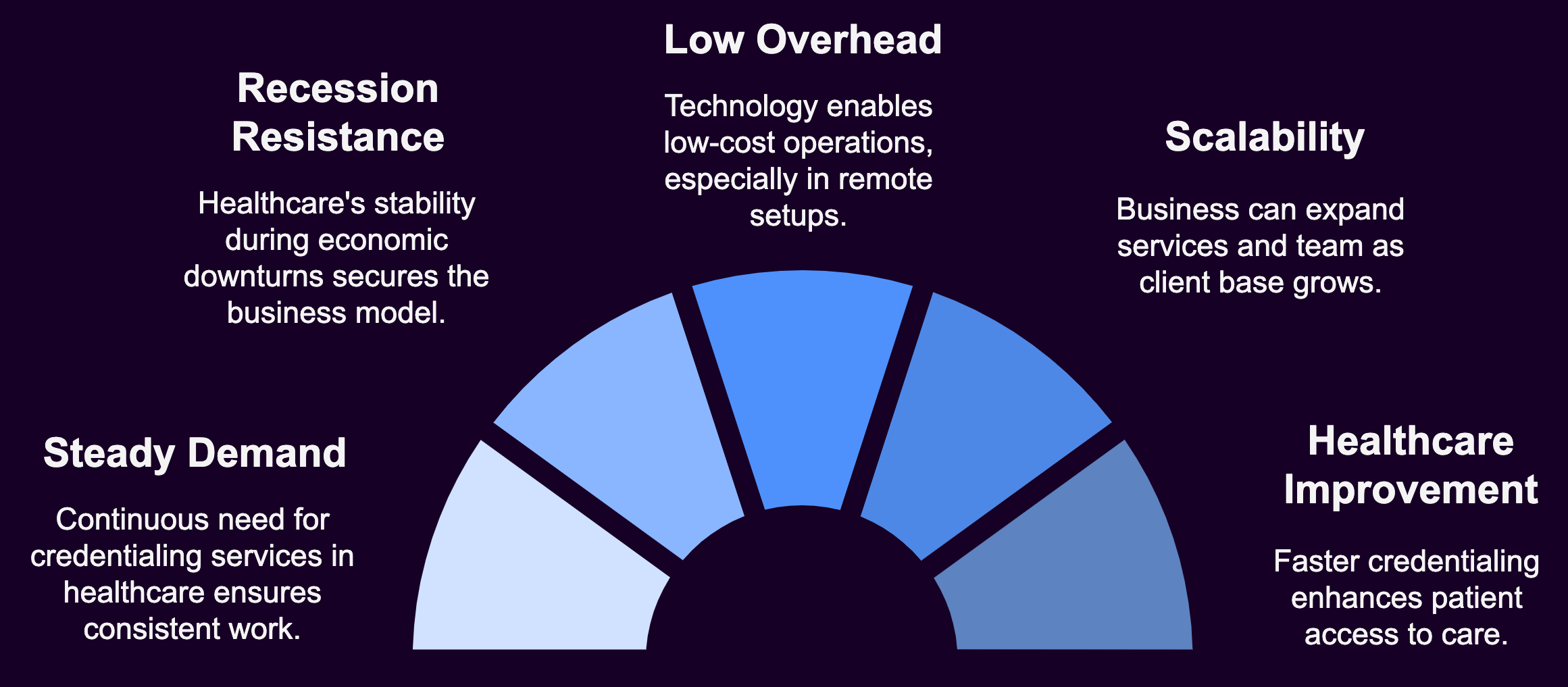Medical credentialing has become an essential service that bridges the gap between healthcare providers and insurance companies. If you’re considering starting a medical credentialing company, you’re looking at an industry with steady demand and significant growth potential.
Why Start a Medical Credentialing Company?
Healthcare is a massive industry with no signs of slowing down. As the number of healthcare providers continues to grow and insurance regulations become increasingly complex, the demand for efficient credentialing services rises.

Here’s why starting a medical credentialing company might be a smart business move:
1. Steady Demand
Every healthcare provider needs credentialing services, and this need is recurring. Credentials need to be maintained and updated regularly, creating a steady stream of work.
2. Recession-Resistant Industry
Healthcare remains relatively stable even during economic downturns. People always need medical care, and providers always need to maintain their credentials.
3. Low Overhead Potential
With the right technology and setup, you can operate a credentialing business with relatively low overhead costs, especially if you start with a remote or home-based model.
4. Scalable Business Model
As you gain clients and experience, you can expand your services and grow your team to handle increased volume.
5. Opportunity to Improve Healthcare
By helping qualified providers get properly credentialed faster, you’re indirectly improving patient access to care.
Key Steps to Start Your Medical Credentialing Company
Starting any business requires careful planning and execution.
Here’s a step-by-step guide to launching your medical credentialing company:
Step 1: Gain Industry Knowledge and Experience
Before diving in, it’s crucial to thoroughly understand the credentialing process.
If you don’t have a background in healthcare administration or credentialing, consider:
- Working for an existing credentialing company to gain experience
- Completing credentialing specialist certification programs
- Joining professional organizations like the National Association of Medical Staff Services (NAMSS)
- Attending industry conferences and workshops
- Networking with healthcare administrators and practice managers
Without this foundation, you’ll struggle to provide value to clients and navigate healthcare compliance.
Step 2: Develop a Business Plan
Like any business venture, you need a solid plan.
Your business plan should include:
Market Analysis
- Who are your potential clients in your target geographic area?
- What are the current pain points in the credentialing process?
- Who are your competitors and what do they charge?
Service Offerings
Will you offer:
- Initial credentialing for new providers
- Recredentialing services
- Provider enrollment with insurance companies
- Medicare/Medicaid enrollment
- Hospital privileging
- Ongoing credential maintenance and monitoring
- Supplementary services like background checks or continuing education tracking
Business Model
- Will you charge per provider, per application, or use a subscription model?
- What will be your pricing structure?
- How many clients will you need to break even?
Marketing Strategy
- How will you reach potential clients?
- What will be your unique selling proposition?
Financial Projections
- Startup costs
- Monthly operating expenses
- Revenue projections
- Break-even analysis
Step 3: Handle Legal and Administrative Requirements
To operate legally, you’ll need to:
Form a Legal Entity
Most credentialing companies operate as LLCs or corporations to protect personal assets.
Obtain Necessary Licenses and Permits
Requirements vary by state, so research what’s needed in your location.
Secure Business Insurance
Consider professional liability insurance, general liability insurance, and cyber liability insurance to protect your business from potential claims.
Set Up Business Banking
Keep your business finances separate from personal accounts.
Create Contracts and Service Agreements
Have a lawyer draft or review your client contracts and business agreements.
Step 4: Invest in Technology and Systems
Credentialing is detail-oriented work that requires robust systems.
Consider investing in:
Credentialing Software
Programs like Modio Health, CredentialMyDoc, or MD-Staff can streamline your processes.
Secure Data Storage
Given the sensitive nature of provider information, you’ll need HIPAA-compliant data storage solutions.
Communication Tools
Efficient communication with clients and insurance companies is crucial.
Document Management System
You’ll be handling a lot of paperwork, so a good document management system is essential.
Step 5: Develop Your Processes and Workflows
Credentialing requires meticulous attention to detail and strict adherence to timelines.
Develop clear processes for:
- Intake of new clients
- Gathering provider information
- Submitting applications
- Following up on pending applications
- Tracking credentialing status
- Handling rejections or requests for additional information
- Maintaining credentials and managing renewal timelines
Document these processes thoroughly—they’ll become your operational playbook and a training manual as you grow.
Step 6: Build Your Team
While you might start as a one-person operation, as you grow, you’ll need to build a team.
Consider hiring:
- Additional credentialing specialists
- Customer service representatives
- Sales and marketing professionals
- Administrative support staff
Look for individuals with healthcare administrative experience, attention to detail, and strong communication skills.
Step 7: Market Your Services
With everything in place, it’s time to attract clients.
Consider these marketing strategies:
Develop a Professional Website
Your website should clearly explain your services, emphasize your expertise, and make it easy for potential clients to contact you.
Network within Healthcare Communities
Attend medical conferences, join healthcare administrator groups, and connect with practice managers.
Leverage LinkedIn and Professional Platforms
Build a strong online presence in healthcare professional circles.
Consider Direct Outreach
Identify potential clients and reach out directly with personalized pitches.
Offer Educational Content
Position yourself as an expert by providing valuable content about credentialing best practices.
Ask for Referrals
Once you have satisfied clients, ask them to refer colleagues.
Common Challenges and How to Overcome Them
Starting a medical credentialing company isn’t without its challenges.
Here are some common hurdles and strategies to overcome them:
1. Keeping Up with Changing Regulations
The healthcare industry is heavily regulated, and rules change frequently.
Solution: Join professional organizations, subscribe to industry newsletters, attend continuing education courses, and consider hiring a compliance consultant.
2. Managing High Volume and Tight Deadlines
Credentialing has strict timelines, and managing multiple applications simultaneously can be overwhelming.
Solution: Implement robust project management systems, use automation where possible, and develop clear prioritization processes.
3. Dealing with Incomplete or Inaccurate Information
You’ll often receive incomplete applications or information from providers.
Solution: Create thorough checklists, develop clear communication protocols for following up, and build extra time into your timelines for these inevitable delays.
4. Standing Out in a Competitive Market
As healthcare continues to grow, so does the number of credentialing services.
Solution: Find your niche (perhaps specializing in a particular medical specialty or geographic region), provide exceptional customer service, and develop a strong value proposition.
Scaling Your Medical Credentialing Business
Once you’ve established your company and have a steady client base, you might consider scaling your business.
Here are some strategies for growth:
1. Expand Your Service Offerings
Consider adding complementary services such as:
- Provider enrollment audits
- Locum tenens credentialing
- Telehealth credentialing
- Continuing education tracking
- Background screening services
2. Target New Markets
Expand your geographic reach or focus on specific healthcare specialties or settings:
- Rural healthcare providers
- Telehealth companies
- Mental health providers
- Specialty surgical centers
- Urgent care networks
3. Develop Partnerships
Form strategic partnerships with:
- Electronic Health Record (EHR) companies
- Practice management consultants
- Healthcare staffing agencies
- Medical billing companies
4. Leverage Technology
Invest in technology to improve efficiency and client experience:
- Develop a client portal for real-time status updates
- Implement automation for routine tasks
- Use data analytics to identify bottlenecks and improve processes
The Financial Side: What to Expect
Understanding the financial aspects of a medical credentialing business is crucial for planning and sustainability.
Startup Costs
Initial investment typically ranges from $5,000 to $50,000, depending on your approach.
Key expenses include:
- Business registration and legal fees: $500-$2,000
- Credentialing software: $2,000-$20,000 annually
- Computer equipment and office setup: $2,000-$5,000
- Website development: $1,000-$5,000
- Marketing materials: $500-$2,000
- Insurance: $1,000-$3,000 annually
- Training and certifications: $500-$2,000
Revenue Potential
Revenue varies widely based on your pricing model, services offered, and client base.
Common pricing structures include:
- Per-provider fee: $500-$1,000 for initial credentialing
- Monthly retainer: $100-$300 per provider for ongoing maintenance
- Per-application fee: $150-$500 per insurance application
A solo practitioner might manage 20-30 providers, generating $60,000-$150,000 annually. As you scale with additional staff, revenue can increase significantly.
Profit Margins
With efficient operations, medical credentialing businesses can achieve profit margins of 20-40% after covering expenses like:
- Staff salaries
- Software subscriptions
- Office space (if applicable)
- Marketing
- Insurance
- Professional development
Building Long-term Success
Beyond the initial startup phase, building a sustainable credentialing business requires:
1. Delivering Consistent Quality
Credentialing mistakes can have serious consequences for providers and patients. Maintain rigorous quality control processes and regularly audit your work.
2. Cultivating Client Relationships
The cornerstone of a successful credentialing business is strong client relationships. Regularly check in with clients, solicit feedback, and make improvements based on their input.
3. Staying Ahead of Industry Trends
Keep an eye on emerging trends that might impact your business:
- Telehealth expansion
- Blockchain for credential verification
- Artificial intelligence in healthcare administration
- Changing insurance requirements
- Healthcare legislation updates
4. Investing in Your Team
As your business grows, your team becomes your most valuable asset. Invest in their professional development, create a positive work environment, and recognize their contributions.
5. Measuring and Improving
Implement key performance indicators (KPIs) to measure your business’s health:
- Turnaround time for applications
- Application acceptance rate
- Client retention rate
- Revenue per client
- Staff productivity
Regularly review these metrics and develop strategies to improve them.
Summary: Start Your Own Medical Credentialing Company
Starting a medical credentialing company can be a rewarding venture, both financially and professionally. You’ll be providing a crucial service that helps healthcare providers focus on what they do best, caring for patients, while you handle the complex administrative work of credentialing.
Success in this field requires attention to detail, knowledge of healthcare regulations, strong organizational skills, and excellent customer service. With proper planning, investment in the right systems, and a commitment to quality, your medical credentialing company can thrive in the growing healthcare industry.
Most successful credentialing businesses aren’t just processing paperwork, they’re true partners to their healthcare clients, helping them with healthcare compliance and reimbursement. As a partner, you’ll build a loyal client base and a sustainable business that can weather the inevitable changes in the healthcare landscape.
Are you ready to take the plunge into the medical credentialing industry? We did and we’re not looking back.

